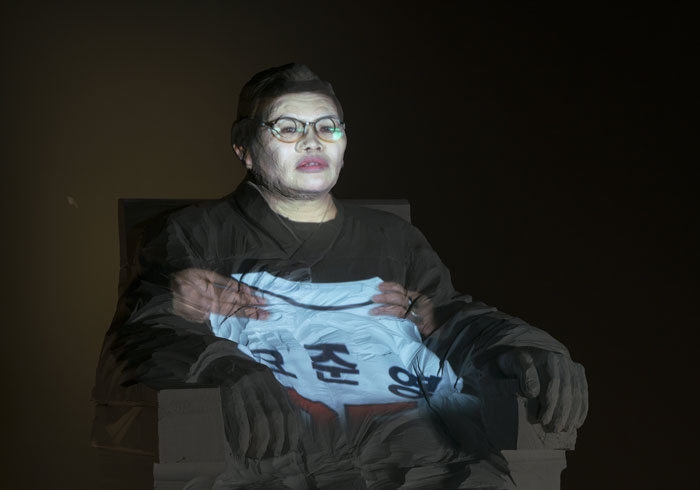National Museum of Modern and Contemporary Art, Seoul, 5 July – 9 October
Over the course of a five-decade career, public space – both in the sense of a space that assembles or constructs a public and in the sense of a space for making things (such as trauma, discrimination and political oppression) public – has become Polish-born, New York-based Krzysztof Wodiczko’s medium. And to some extent the potential of public space, as both a revelatory and healing force for society, has become his message. While his large-scale projects, often involving projections on monuments or the facades of public buildings, have taken place across Europe, Central and North America, Australia and Japan, he has never made such a work in South Korea. On the face of it, then, encountering a comprehensive retrospective of his work in Korea’s national museum might seem a little odd, in that it appears to speak about the problems of everywhere else except here: for example, that of the survivors of nuclear bombing in Hiroshima Projection (1999), and the status of female labourers in The Tijuana Projection (2001), both of which feature projections of local people voicing their personal experiences on iconic buildings rooted in specific geographies and histories.
Organised (as the title suggests) by medium, the exhibition itself documents Wodiczko’s career chronologically from early experiments in the definition of personal space, born out of the artist’s work in industrial design in Poland and the country’s then totalitarian regime. One of the earliest of these, Personal Instrument (1969), designed to be used by the artist himself (in this case, as with many other works from this period, in the street rather than the gallery), comprises noiseproof headphones which transmit sound picked up by a microphone, isolated and filtered by hand movement through photo-receivers embedded in a pair of gloves – the artist carving out a space for himself. The exhibition display moves on through a series of awkward vehicles aimed at critiquing the easy linkage of technology and progress, before culminating in the series of epic projections (presented via video documentation of the events). Along the way there’s a clear interest in tracing how the psychological projections of individuals find their place within the collective psychology of a social whole.
Clearly, Wodiczko’s interest in what constitutes a democracy chimes with the demonstrations in Seoul that preceded the recent impeachment of Park Geun-hye. With that in mind, the exhibition culminates in a new work, My Wish (2017), which takes the form of a video projection of Koreans from various walks of life (among them the mother of a victim of the Sewol ferry disaster, a recently laid-off worker, and a North Korean defector) 3D mapped onto a reconstruction of a seated statue of Kim Koo (who led the Korean independence movement against the Japanese and from whose writings the title of the work derives), as they talk about their hopes for the future of the country. That the work is in the museum rather than at the site of the monument, and consequently comes with a more heightened sense of artifice (and self-servience – celebrating the emergence of the art museum as a generator for a ‘public’) than some of Wodiczko’s site-specific work, says something about how open South Korean society is. Moreover, the double simulacrum (of the monument and of the people projected onto it) brings to mind the fact that public space today might be as much virtual as it is physical. In this respect some of Wodiczko’s techniques seem prescient: in terms, for example, of his work presenting the animated future cityscapes of movies such as Blade Runner (1982) or Ghost in the Shell (2017) made real, and in the way in which his projections offer a sense of community that might be a kind of analogue Facebook. Other aspects of Wodiczko’s work can seem a little old-fashioned however: in the museum, his instruments and vehicles seem too much like archaeological relics. But perhaps this type of art is always destined to belong as much to the domain of sociology as it is art history.
From the Autumn 2017 issue of ArtReview Asia
